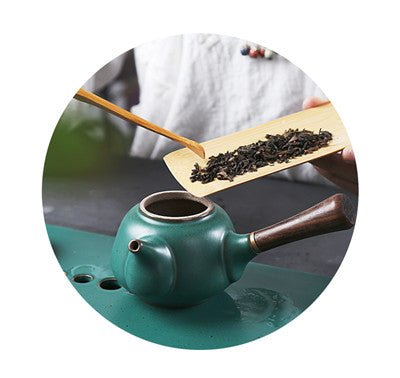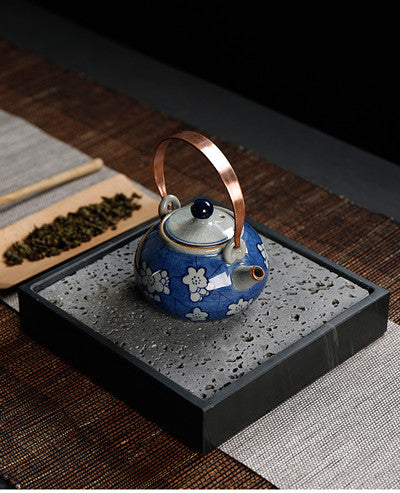Introduction of Japanese Tea Ceremony
Japanese tea ceremony is a kind of ritual service for guests in Japan. Originally known as "tea soup". Like other East Asian tea ceremonies, Japanese tea ceremony is a special culture developed mainly for tea tasting, but the content and form are different form the other country.
The history of the tea ceremony can be traced back to the 13th century. At first, the monks used tea to concentrate their thoughts, and later it became a ceremony to share tea and snacks. Nowadays Japanese tea ceremony is divided into matcha ceremony and sencha ceremony, but the tea ceremony refers to the matcha ceremony which has developed earlier. In the modern tea ceremony, most of the host prepares tea, snacks, and fruits to entertain the guests, and both the host and the guests follow fixed rules and procedures. Besides the food, the spirit of the tea ceremony also extends to other aspects; the layout of the tea room, the decoration of the garden, and the teaware for drinking tea are the key points of the tea ceremony.
Tea ceremony is very popular in Japan, which is deeply influenced by Chinese tea culture. So the small and exquisite of tea sets are the pursuit of Japanese. Although, more people will be surprised by the so small quantity when frying tea. As the Japanese tea sets what we can see are relatively small. With the evolution of history, the varieties of Japanese tea pots are increased day by day. And also its tea pots are of the specific value of artistic and aesthetic.
Thanks to the clever technician of Japan, various of art treasures are created. There are three major tea-producing area in Japan : Ashiya Mizuki, Tenmei, Kyoto. It is said that the teapot has no two are the completely same. In line with the spirit of craftsman, all of the Japanese teapot are made by hand. As for its style, its give priority to the Japanese Teapot with hand held and the ones with side fantasy.
Influenced by Chinese tea set, there are many different kinds of Japanese tea pot, which could be made by pottery, porcelain, lacquer, iron, bronze, wood, bamboo, and so on. On the other hand, the Japanese tea pot have a characteristics of mild curve and round, having both ornamental and using function. By contrast, the Japanese tea pot is not as diverse as Chinese tea pot. It has some trait of reserving, mostly are quietly pure and fresh in style, and simple but elegant in color, favoring to show the original face of the material.
Both Chinese teapots and Japanese teapots have a long history. But after a long period of development between both of them, while learning from each other, there are also many differences.
1.The usage is different. The Chinese teapots are mainly use for brewing tea. Japanese teapots are boilers, which are equivalent to our teapots for boiling water.
2.In aesthetic appeal aspect, Chinese teapots probably have two main lines of development. One is used by the court and nobles, like pastel teapot . Another main line of development is for literati taste, which is largely manifested in Yixing purple clay teapots. Most of these teapots do not pursue gorgeous and changeable shapes. It pays more attention to the literati traditions since the ancient Ming Dynasty, for example, they pursuit of mountains and rivers, scenery and put the pursuit of a lifetime into the tea. In Japan, whether it is emperor or the common people, what they pursue is a kind of calmness, a kind of harmony with nature, which is related to their national characteristics and cultural traditions. So just from the teapot itself, we can't even clearly distinguish whether a teapot comes from a royal family or an ordinary person. But the overall performance is simple and simple, it’s more similar to Chinese literati tradition.
There is vast collection of Japanese teapots suitable for various occasion. The shape and size of Japanese ceramic teapots makes it a popular choice for many. If you are tea lover or looking for Japanese teapots, with these antique Japanese teapots are a smart choice.
Japanese tea ceremony is a kind of ritual service for guests in Japan. Originally known as "tea soup". Like other East Asian tea ceremonies, Japanese tea ceremony is a special culture developed mainly for tea tasting, but the content and form are different form the other country.
The history of the tea ceremony can be traced back to the 13th century. At first, the monks used tea to concentrate their thoughts, and later it became a ceremony to share tea and snacks. Nowadays Japanese tea ceremony is divided into matcha ceremony and sencha ceremony, but the tea ceremony refers to the matcha ceremony which has developed earlier. In the modern tea ceremony, most of the host prepares tea, snacks, and fruits to entertain the guests, and both the host and the guests follow fixed rules and procedures. Besides the food, the spirit of the tea ceremony also extends to other aspects; the layout of the tea room, the decoration of the garden, and the teaware for drinking tea are the key points of the tea ceremony.

Tea ceremony is very popular in Japan, which is deeply influenced by Chinese tea culture. So the small and exquisite of tea sets are the pursuit of Japanese. Although, more people will be surprised by the so small quantity when frying tea. As the Japanese tea sets what we can see are relatively small. With the evolution of history, the varieties of Japanese tea pots are increased day by day. And also its tea pots are of the specific value of artistic and aesthetic.
Thanks to the clever technician of Japan, various of art treasures are created. There are three major tea-producing area in Japan : Ashiya Mizuki, Tenmei, Kyoto. It is said that the teapot has no two are the completely same. In line with the spirit of craftsman, all of the Japanese teapot are made by hand. As for its style, its give priority to the Japanese Teapot with hand held and the ones with side fantasy.
Influenced by Chinese tea set, there are many different kinds of Japanese tea pot, which could be made by pottery, porcelain, lacquer, iron, bronze, wood, bamboo, and so on. On the other hand, the Japanese tea pot have a characteristics of mild curve and round, having both ornamental and using function. By contrast, the Japanese tea pot is not as diverse as Chinese tea pot. It has some trait of reserving, mostly are quietly pure and fresh in style, and simple but elegant in color, favoring to show the original face of the material.

Both Chinese teapots and Japanese teapots have a long history. But after a long period of development between both of them, while learning from each other, there are also many differences.
1.The usage is different. The Chinese teapots are mainly use for brewing tea. Japanese teapots are boilers, which are equivalent to our teapots for boiling water.
2.In aesthetic appeal aspect, Chinese teapots probably have two main lines of development. One is used by the court and nobles, like pastel teapot . Another main line of development is for literati taste, which is largely manifested in Yixing purple clay teapots. Most of these teapots do not pursue gorgeous and changeable shapes. It pays more attention to the literati traditions since the ancient Ming Dynasty, for example, they pursuit of mountains and rivers, scenery and put the pursuit of a lifetime into the tea. In Japan, whether it is emperor or the common people, what they pursue is a kind of calmness, a kind of harmony with nature, which is related to their national characteristics and cultural traditions. So just from the teapot itself, we can't even clearly distinguish whether a teapot comes from a royal family or an ordinary person. But the overall performance is simple and simple, it’s more similar to Chinese literati tradition.
There is vast collection of Japanese teapots suitable for various occasion. The shape and size of Japanese ceramic teapots makes it a popular choice for many. If you are tea lover or looking for Japanese teapots, with these antique Japanese teapots are a smart choice.
